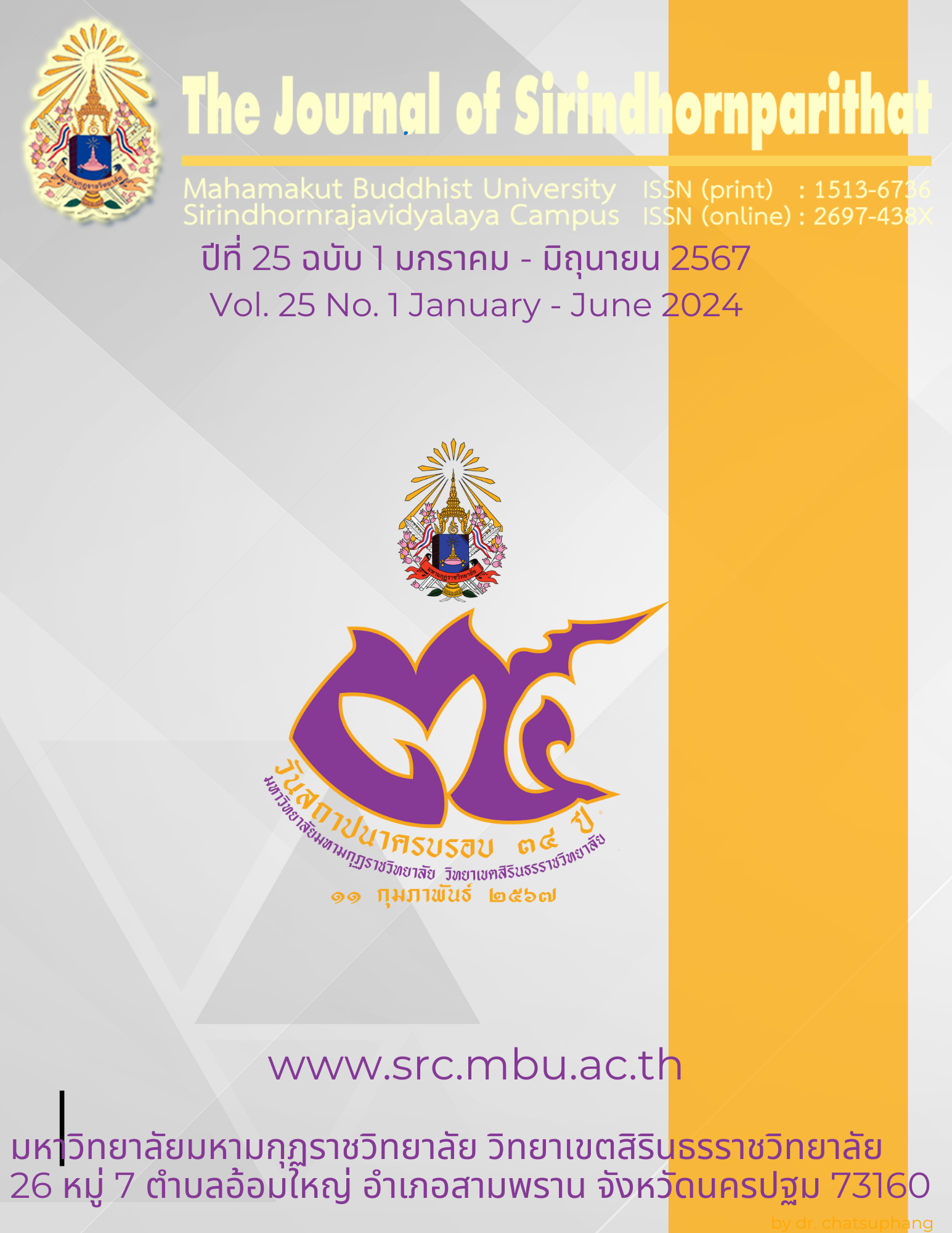The development of virtual museum for ratchaburi national museum
Keywords:
development, Virtual Museum, Learning, National Museum RatchaburiAbstract
Objectives of the research 1) To develop a virtual museum for learning. Ratchaburi National Museum 2) to study the opinions of visitors to the virtual museum for learning Ratchaburi National Museum. Samples used in the research. 30 people came to see the Ratchaburi National Museum by volunteers (Volunteer Sampling). Research instruments 1) Interview form of the museum staff. and experts in the design of virtual media; 2) a virtual museum for learning Ratchaburi National Museum 3) Questionnaire on the opinions of visitors towards virtual museum media for learning. Ratchaburi National Museum.
The research finding were as follow:
1) Results of development and quality assessment Virtual Museum for Learning The content aspect of the National Museum, Ratchaburi, had a mean of 4.33 and the standard deviation of S.D. was 0.22, which meant that the media was of good quality. The media quality assessment item with the highest average was The content is useful to learners with an average value of 4.67 with very good quality. and content quality assessment items The lowest mean is The content can satisfy the difference between having an average of 4.00 with good quality.
2) The results of the study of visitors' opinions on virtual media design media for learning about the system Virtual Museum for Learning The overall average was 4.40 and the S.D. standard deviation was 0.13. Virtual Museum for Learning Ratchaburi National Museum agrees to a good extent. The evaluation item with the highest average score was Knowing more about the culture and way of life of people in Ratchaburi province has an average value of 4.50 and the standard deviation of S.D. is 0.51, meaning the level of the opinions of the visitors is very good. and the media quality assessment item with the lowest mean was beautiful graphics, good meaning, with an average value of 4.27, with good quality.
References
กาญจนา อรุณสุขจรี. (2546). จิตวิทยาทั่วไป. กรุงเทพมหานคร : บํารุงสาสน์.
กรกต ธัชศฤงคารสกุล. (2554). การพัฒนาสื่อการออกแบบสื่อเสมือนจริง เรื่อง ดนตรีจีนบางหลวง สำหรับนักเรียนชั้นมัธยมศึกษาปีที่ 2 โรงเรียนเจี้ยนหัว อําเภอบางเลน จังหวัดนครปฐม. วิทยานิพนธ์ ระดับปริญญาศึกษาศาสตรมหาบัณฑิต ภาควิชาเทคโนโลยีการศึกษา คณะศึกษาศาสตร์ มหาวิทยาลัยศิลปากร.
บุญชม ศรีสะอาด. (2535). การวิจัยเบื้องต้น. พิมพ์ครั้งที่ 2. กรุงเทพมหานคร.สุวีริยาสาส์น,
บุปผชาติ ทัฬห์กรณ์และคนอื่นๆ. (2544). ความรู้เกี่ยวกับสื่อมัลติมมีเดียเพื่อการศึกษา. กรุงเทพมหานคร :โรงพิมพ์คุรุสภาลาดพร้าว.
ประสาท หลักศิลา. (2529). สังคมวิทยา. กรุงเทพมหานคร: โรงพิมพ์ก้าวหน้า.
ปราโมทย์ พงศ์พิสุทธิ์. (2551). การพัฒนาบทเรียนคอมพิวเตอร์มัลติมีเดีย เรื่องสมุนไพรที่ใช้ในงานสาธารณสุขมูลฐาน สำหรับนิสิตเภสัชศาสตร์ ชั้นปีที่ 3. มหาวิทยาลัยศรีนครินทรวิโรฒ.
พิเชษฐ ทองนาวา. (2553). การพัฒนาบทเรียนคอมพิวเตอร์การออกแบบสื่อเสมือนจริง แบบพาโนรามาเสมือนจริง เรื่องพระราชวังสนามจันทร์ สำหรับนักเรียนช่วงชั้นที่ 3. วิทยานิพนธ์ ปริญญามหาบัณฑิตภาควิชาเทคโนโลยีการศึกษา คณะศึกษาศาสตร์ มหาวิทยาลัยศิลปากร.
ฤทธิชัย อ่อนนิ่ง. (2547). การออกแบบและพัฒนาบทเรียนคอมพิวเตอร์มัลติมีเดีย. กรุงเทพมหานคร :ภาควิชาเทคโนโลยีทางการศึกษาคณะศึกษาศาสตร์ มหาวิทยาลัยศรีนครินทรวิโรฒ.
สถาพร บางหลวง. (2550). การออกแบบบทเรียนคอมพิวเตอร์ช่วยสอนวิชาองค์ประกอบศิลป์สำหรับนักเรียนมัธยมศึกษาตอนต้น. วิทยานิพนธ์ ปริญญามหาบัณฑิต ภาควิชาเทคโนโลยีการศึกษาคณะศึกษาศาสตร์ มหาวิทยาลัยศิลปากร.
สุชาติ สว่างอารีรักษ์ และคณะ. (2555). ความหลากหลายทรัพยากรพิพิธภัณฑสถานแห่งชาติ ราชบุรี, กรุงเทพมหานคร: โรงพิมพ์อักษรไทย.
สำนักแผนงานและสารสนเทศ กรมอุทยานแห่งชาติ สัตว์ป่า และพันธุ์พืช. (2555). แผนปฏิบัติราชการ 4 ปี (พ.ศ.2555-2558) กรมอุทยานแห่งชาติ สัตว์ป่าและพันธุ์พืช. กรุงเทพมหานคร : กรมอุทยานแห่งชาติ สัตว์ป่า และพันธุ์พืช กระทรวงทรัพยากรธรรมชาติและสิ่งแวดล้อม.
พิพิธภัณฑสถานแห่งชาติ ราชบุรี, มูลนิธิ, (2558). แผนยุทธศาสตร์และแผนปฏิบัติการพิพิธภัณฑสถานแห่งชาติ ราชบุรี.
Beillo, A.D. (2006). A model for developing interactive instructional multimedia application for electronic music instructor. Dissertation Abstracts International, 67(3), 905-A. (UMI No. 3206011).
Brown, Gillian and Yule, George. (1983). Language : Approach based on the analysis of conversational English. Great Britain.
Chu, S. L. (2006). The investigating the effectiveness of redundant text and animation inmultimedia learning development. Dissertation Abstracts International, 67(01), 150-A. (UMI NO. 3210347).
Jing-Ming Ju. (2009). The effects of multimedia stories of deaf or hard-of-hearing of multimedia. ERIC document reproduction service No ED397797.
Kerlinger, F.N; & Lee, H.B. (2000). Foundations of Behavioral Research. (4th edition) United States: Wadsworth, Thomson Learning.
Mark, Nichols. (1971). Community Resources for School. Encyclopidia of Education 2.
Sawsan Nusir et all. (2011). Designing an Interactive Multimedia Learning System for Taiwanes Students with Hearing Impairment. Asian Journal of Management and the Children of Primary Schools in Jordan.
Shih Chung Lee. (2002). Evaluation and Development of user interface of Quick-Time VR, Image based environment for distance learning classroom at tamkang university. [Online]. Available from : http://www.adprima.com/ijim.html
Shenchang Eric Chen. (1995). QuickTime VR : an image-based approach to virtual environment navigation. New York, NY, USA : ACM Press.

Downloads
Published
Issue
Section
License
Copyright (c) 2024 Mahamakut Buddhist University

This work is licensed under a Creative Commons Attribution-NonCommercial-NoDerivatives 4.0 International License.
บทความที่ได้รับการตีพิมพ์เป็นลิขสิทธิ์ของ มหาวิทยาลัยมหามกุฏราชวิทยาลัย วิทยาเขตสิรินธรราชวิทยาลัย
ข้อความที่ปรากฏในบทความแต่ละเรื่องในวารสารวิชาการเล่มนี้เป็นความคิดเห็นส่วนตัวของผู้เขียนแต่ละท่านไม่เกี่ยวข้องกับหาวิทยาลัยมหามกุฏราชวิทยาลัย วิทยาเขตสิรินธรราชวิทยาลัย และคณาจารย์ท่านอื่นๆในมหาวิทยาลัยฯ แต่อย่างใด ความรับผิดชอบองค์ประกอบทั้งหมดของบทความแต่ละเรื่องเป็นของผู้เขียนแต่ละท่าน หากมีความผิดพลาดใดๆ ผู้เขียนแต่ละท่านจะรับผิดชอบบทความของตนเองแต่ผู้เดียว



